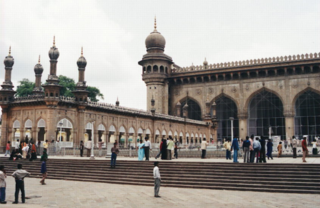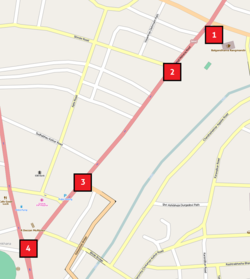
The 2005 Delhi bombings occurred on 29 October 2005 in Delhi, India, killing 62 people and injuring at least 210 others in three explosions. The bombings came only two days before the important festival of Diwali, which is celebrated by Hindus, Sikhs, and Jains. The bombs were triggered in two markets in central and south Delhi and in a bus south of the city. The Pakistani Islamist terrorist group Lashkar-e-Taiba claimed responsibility for the attacks under the pseudonym of Islamic Inquilab Mahaz. The Indian Mujahideen is also suspected of involvement.

The Mecca Masjid blast occurred on 18 May 2007 inside the Mecca Masjid, a mosque located in the old city area of Hyderabad, capital of the Indian state of Telangana located very close to Charminar. The blast was caused by a cellphone-triggered pipe bomb placed near the Wuzukhana, a spot where ablutions are performed. Two more live IEDs were found and defused by the police. Sixteen people were reported dead in the immediate aftermath, of whom five were killed by the police firing after the incident while trying to quell the mob.

The Jaipur bombings were a series of nine synchronized bomb blasts that took place on 13 May 2008 within a span of fifteen minutes at locations in Jaipur, the capital city of the Indian state of Rajasthan, and a tourist destination. Official reports confirm 63 dead with 216 or more people injured. The bombings shocked most of India and resulted in widespread condemnation from leaders across the world with many countries showing solidarity with India in its fight against terrorism.
The 2008 Ahmedabad bombings were a series of 21 bomb blasts that hit Ahmedabad, India, on 26 July 2008, within a span of 70 minutes. Fifty-six people were killed and over 200 people were injured. Ahmedabad is the cultural and commercial heart of Gujarat state and a large part of western India. The blasts were considered to be of low intensity and were similar to the Bangalore blasts, Karnataka which occurred the day before. This bombings were done by Islamic Terrorist group Harkat-ul-Jihad al-Islami.
Indian Mujahideen (IM) is an Islamic terrorist group which has been particularly active in India. The jihadist group was founded as an offshoot of the Students' Islamic Movement of India (SIMI) by several radicalized members including Iqbal Bhatkal, Riyaz Bhatkal, Yasin Bhatkal, Abdul Subhan Qureshi, Amir Reza Khan and Sadiq Israr Sheikh, among others. It has been active since at least 2005 when it bombed the Dashashwamedh Ghat in Varanasi. It carried out several serial-bombings in Indian cities in the following years notably the 2007 Uttar Pradesh bombings, 2008 Jaipur bombings, 2008 Ahmedabad bombings, 2008 Delhi bombings, 2010 Pune bombing, 2011 Mumbai bombings, 2011 Delhi bombing, 2013 Patna bombings, 2013 Hyderabad blasts and the 2013 Bodh Gaya bombings.
The 13 September 2008 Delhi bombings were a series of five synchronised bomb blasts that took place within a span of few minutes on Saturday, 13 September 2008 at various locations in Delhi, India. The first bomb exploded at 18:07 IST, and four other blasts followed in succession, with at least 20 people killed and over 90 injured.

The 27 September 2008 Delhi bombing in India's second largest metropolis left three people dead and twenty-three more injured, on an infamous Saturday. The explosion occurred at 14:15, in Mehrauli's Electronic market called Sarai. Initially, there were reports of two persons, including a thirteen-year-old boy, named Santosh being killed in the attack. However, the next day the death toll rose to three. About 23 others were injured and were treated at AIIMS and Fortis Hospital. The bombing took place exactly two weeks after the five serial blasts in Delhi on 13 September 2008.
The 2010 Pune bombing, also known as 13/7 and the German bakery blast, occurred on 13 February 2010 at approximately 19:15 Indian Standard Time, when a bomb exploded at a German bakery in the Indian city of Pune, Maharashtra. The blast killed 18 people, and injured at least 60 more, including an Italian woman, two Sudanese students and an Iranian student.
The 2010 Jama Masjid attack occurred on 19 September 2010 when two gunmen on a motorcycle fired at a tourist bus near Gate 3 of the Jama Masjid in Old Delhi, India and injured two Taiwanese tourists. The incident provoked fears about security for the upcoming Commonwealth Games in Delhi. About three hours later a car parked approximately 150 meters from the spot caught fire, apparently due to a minor blast.
The Batla House encounter case was an armed Delhi Police operation to arrest terrorists of the Indian terror outfit Indian Mujahideen, hiding in a flat in the Batla House area of Jamia Nagar, Okhla, on 19 September 2008. The operation resulted in the deaths of two terrorists and one police officer, Inspector Mohan Chand Sharma, with the remaining terrorists arrested. On 15 March 2021, one of the arrested Ariz Khan alias Junaid, was sentenced to death for the murder of Inspector Sharma.
The 2011 Mumbai bombings, also known as 13/7, were a series of three coordinated bomb explosions at different locations in Mumbai, India, on 13 July 2011 between 18:54 and 19:06 IST. The blasts occurred at the Opera House, at Zaveri Bazaar and at Dadar West localities, leaving 26 killed and 130 injured. Indian Mujahideen is believed to have carried out the attack with the personal involvement of its co-founder Yasin Bhatkal.
The 2011 Delhi bombing took place in the Indian capital Delhi on Wednesday, 7 September 2011 at 10:14 local time outside Gate No. 5 of the Delhi High Court, where a suspected briefcase bomb was planted. The blast killed 15 people and injured 79. Harkat-ul-Jihad al-Islami claimed responsibility for the attack, and is believed to have carried out the attack with support from the Indian Mujahideen, it stated motive was the commuting of the death sentence for 2001 Indian Parliament attack convict Afzal Guru.
2010 Bangalore stadium bombing occurred on 17 April 2010 in M. Chinnaswamy Stadium, Bangalore, India before a 2010 Indian Premier League match between the Royal Challengers Bangalore and Mumbai Indians. Two bombs exploded around a heavily packed Cricket stadium in which fifteen people were injured. A third bomb was defused outside the stadium. According to the Bangalore City Police, the blasts were caused by low-intensity crude bombs made of powergel which is used in quarrying and were triggered by timers. On 18 April, two more bombs were located near the stadium during search operations.
Shah Riyaz Ahmad Mohammed Ismail Shahbandari, known as Riyaz Bhatkal, is the co-founder, leader and a wanted terrorist of Indian Mujahideen, a terrorist group based in India. Riyaz Ismail Shahbandri is one of the Indian Mujahideen's three top commanders and is currently based in Karachi, Pakistan along with his brother Iqbal Bhatkal.
Iqbal Shahbandri, known as Iqbal Bhatkal, is the co-founder, ideologue, leader and wanted terrorist of the Indian Mujahideen, an Islamist terrorist group based in India. He is the brother of another IM co-founder Riyaz Bhatkal, and is one of the Indian Mujahideen's three top commanders. Both him and his brother are currently based in Karachi, Pakistan.
Syed Mohammed Ahmed Zarar Siddibappa, known as Yasin Bhatkal, is a convicted Indian Islamist terrorist, who was the co-founder and leader of the proscribed terrorist organisation Indian Mujahideen (IM). Yasin along with Riyaz Bhatkal and Iqbal Bhatkal, among others, founded the terrorist organisation around 2005. The jihadist group has carried out several attacks against civilian targets in India and Yasin was notably personally involved in the 2010 Pune bombing, 2010 Bangalore stadium bombing, 2011 Mumbai bombings, 2012 Pune bombings and the 2013 Hyderabad blasts.

On 21 February 2013, at around 19:00 IST, two blasts occurred in the city of Hyderabad, India. The bombs exploded in Dilsukhnagar, a crowded shopping area, within 100 metres (330 ft) of each other. The first explosion occurred outside a roadside eatery named A1 Mirchi, next to the Anand Tiffin Centre and opposite the Konark movie hall, followed by the second one two minutes later near the Route 107 bus stand close to the Venkatadri theatre. In December 2016, Yasin Bhatkal - the co-founder of Indian Mujahideen, Pakistani national Zia-ur-Rahman, Asadullah Akhtar, Tahaseen Akhtar, and Ajaz Shaikh were given a death-sentence by a National Investigation Agency special court for carrying out the attacks under the Arms Act, Explosive Substances Act and Prevention of Damage to Public Property Act.

On 7 July 2013 a series of ten bombs exploded in and around the Mahabodhi Temple complex, a UNESCO World Heritage Site in Bodh Gaya, India. Five people, including two Buddhist monks, were injured by the blasts. Three other devices were defused by bomb-disposal squads at a number of locations in Gaya.

On 27 October 2013, a series of bomb blasts rocked the Indian city of Patna, Bihar at a massive election rally for BJP Prime Ministerial candidate and current Prime Minister Narendra Modi. Of the estimated 300,000 participants at the "Hunkar" rally, six people were killed and 85 others were injured in eight bomb blasts.









